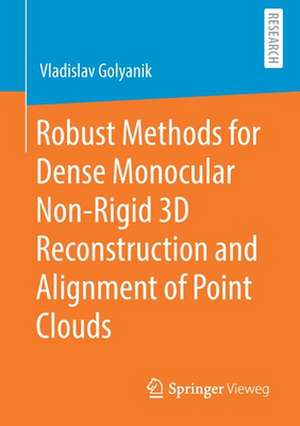Robust Methods for Dense Monocular Non-Rigid 3D Reconstruction and Alignment of Point Clouds
Autor Vladislav Golyaniken Limba Engleză Paperback – 5 iun 2020
About the Author:
Vladislav Golyanik is currently a postdoctoral researcher at the Max Planck Institute for Informatics in Saarbrücken, Germany. The current focus of his research lies on 3D reconstruction and analysis of general deformable scenes, 3D reconstruction of human body and matching problems on point sets and graphs. He is interested in machine learning (both supervised and unsupervised), physics-based methods as well as new hardware and sensors forcomputer vision and graphics (e.g., quantum computers and event cameras).
Preț: 589.70 lei
Preț vechi: 737.12 lei
-20% Nou
Puncte Express: 885
Preț estimativ în valută:
112.84€ • 120.66$ • 94.08£
112.84€ • 120.66$ • 94.08£
Carte tipărită la comandă
Livrare economică 17 aprilie-01 mai
Preluare comenzi: 021 569.72.76
Specificații
ISBN-13: 9783658305666
ISBN-10: 3658305665
Pagini: 352
Ilustrații: XXIV, 352 p. 119 illus., 13 illus. in color.
Dimensiuni: 148 x 210 mm
Greutate: 0.45 kg
Ediția:1st ed. 2020
Editura: Springer Fachmedien Wiesbaden
Colecția Springer Vieweg
Locul publicării:Wiesbaden, Germany
ISBN-10: 3658305665
Pagini: 352
Ilustrații: XXIV, 352 p. 119 illus., 13 illus. in color.
Dimensiuni: 148 x 210 mm
Greutate: 0.45 kg
Ediția:1st ed. 2020
Editura: Springer Fachmedien Wiesbaden
Colecția Springer Vieweg
Locul publicării:Wiesbaden, Germany
Cuprins
Scalable Dense Non-rigid Structure from Motion.- Shape Priors in Dense Non-rigid Structure from Motion.- Probabilistic Point Set Registration with Prior Correspondences.- Point Set Registration Relying on Principles of Particle Dynamics.
Notă biografică
Vladislav Golyanik is currently a postdoctoral researcher at the Max Planck Institute for Informatics in Saarbrücken, Germany. The current focus of his research lies on 3D reconstruction and analysis of general deformable scenes, 3D reconstruction of human body and matching problems on point sets and graphs. He is interested in machine learning (both supervised and unsupervised), physics-based methods as well as new hardware and sensors for computer vision and graphics (e.g., quantum computers and event cameras).
Textul de pe ultima copertă
Vladislav Golyanik proposes several new methods for dense non-rigid structure from motion (NRSfM) as well as alignment of point clouds. The introduced methods improve the state of the art in various aspects, i.e. in the ability to handle inaccurate point tracks and 3D data with contaminations. NRSfM with shape priors obtained on-the-fly from several unoccluded frames of the sequence and the new gravitational class of methods for point set alignment represent the primary contributions of this book.
Contents
- Scalable Dense Non-rigid Structure from Motion
- Shape Priors in Dense Non-rigid Structure from Motion
- Probabilistic Point Set Registration with Prior Correspondences
- Point Set Registration Relying on Principles of Particle Dynamics
Target Groups
- Scientists and students in the fields of computer vision and graphics, machine learning, applied mathematics as well asrelated fields
- Practitioners in industrial research and development in these fields
About the Author
Vladislav Golyanik is currently a postdoctoral researcher at the Max Planck Institute for Informatics in Saarbrücken, Germany. The current focus of his research lies on 3D reconstruction and analysis of general deformable scenes, 3D reconstruction of human body and matching problems on point sets and graphs. He is interested in machine learning (both supervised and unsupervised), physics-based methods as well as new hardware and sensors for computer vision and graphics (e.g., quantum computers and event cameras).
Caracteristici
Computer vision primer: state-of-the-art methods
